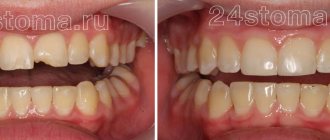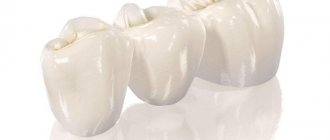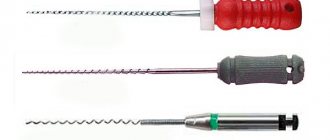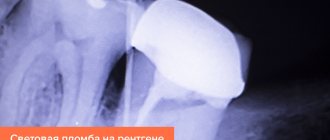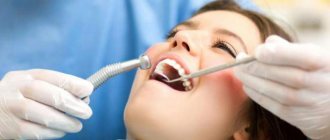2478
Spectrum is the newest development in the world of photopolymer hybrid universal materials for eliminating defects on the chewing and frontal elements of the dentition.
Non-toxic composite allows you to install long-lasting fillings.
Spectrum filling material has excellent polishability and mirror-like shine. Used in aesthetic dentistry.
System components
Spectrum is used for the restoration of chewing teeth, as it can withstand heavy loads.
The front teeth are also filled with composite. The material is endowed with “chameleon” properties, allowing you to achieve a perfect match to the color and transparency of the tooth being restored.
The selection of shade can be done using the Vita scale. Perfect filling is achieved in the simplest way.
The role of the filler (57% of the total volume) in the composite will be played by barium glass, as well as sintered silicon. The microparticles of this filler are very small in size - 0.8 microns.
This feature allows for high-quality polishing of the finished surface to a shine. Characterized by a high degree of marginal fit. The likelihood of cracks, chips, and the development of recurrent caries is very low.
Available in the form of syringes (4.5 g) or ready-made compules (0.25 g).
"Spectrum" set in syringes includes:
- 6 syringes of 4.5 grams of various shades (A3, A2, A3.5, O-A3.5 O-A2, B2);
- 1 Prime & Bond 4.5 ml;
- 25 pcs. application needles;
- 50 pcs. applicators;
- 1 PC. DETREY conditioner 3 ml;
- 1 instructions.
"Spectrum" set in compules:
- 52 pcs. Compule 0.25 g;
- 1 PC. pistol for using compule;
- 1 tube Prime & Bond 4.5 ml;
- 50 pcs. applicators;
- 1 PC. Shade Guide;
- 1 PC. DETREY conditioner 3 ml;
- 25 pcs. application needles;
- 1 instructions.
Features of the component sets:
- blue gel conditioner
- Prime & Bond is both a primer and an adhesive that simplifies the treatment procedure and guarantees excellent adhesion and good marginal seal;
- an applicator gun is a device that allows you to carefully apply the composite into the cavity;
- Illustrated instructions help to perform fillings correctly;
- The syringe caps are colored according to the Vita scale and help dentists choose the right shade.
Compound:
- Base: urethane modification Bis-GMA
- Filler: barium glass and silicon dioxide
- Main filler size: <1um
- Filler content by weight: 77%
- Filler content by volume: 57%
- Compressive strength: 383 MPa
- Diametric strength: 71 MPa
- Transverse strength; 145 MPa
- Modulus of elasticity: 10.572 MPa
- Water absorption: 12um/mm3
- Visible opacity: 30 - incisal shade 41 - standard shade 50 - opaque shade
- Radiopacity: 3 mm aluminum
Indications and contraindications
Recommended for the restoration of all types of dental elements, both anterior and lateral. Used exclusively in dentistry.
Spectrum is contraindicated in patients allergic to methacrylate or acrylate plastics. To prevent irritation, it is important to avoid contact with eyes, mucous membranes or skin. If contact occurs, the area must be immediately washed with water.
Side effects and storage conditions
In case of accidental contact of the photopolymer material with the eyes, irritation and damage to the cornea may occur. Contact of the substance with the skin and mucous membrane of the oral cavity threatens the development of an allergic reaction, the appearance of a rash and inflammation.
Affected areas must be thoroughly cleaned of particles of material and rinsed with plenty of water. If the allergic reaction persists, seek medical help.
It is necessary to store Spectrum filling material at an air temperature of no higher than 24 degrees Celsius in a place protected from sunlight and drops of water.
After squeezing the composite out of the syringe, the product must be tightly closed with a cap to prevent exposure of the substance to sunlight.
It is prohibited to use composite material after its expiration date.
Advantages
Spectrum is designed for the combined use of DETREY conditioner and Prime&Bond adhesive. With their help, dentin and enamel are prepared for applying a filling agent in one step.
The duration of the dental procedure, as well as the amount of materials used, is significantly reduced. At the same time, the quality of work is high.
The advantage of the composite for the patient:
- cannot be distinguished from a natural tooth by color;
- maximum degree of marginal fit, and this property reduces the likelihood of recurrent caries;
- excellent durability, low likelihood of abrasion;
- after polishing, the restored units do not differ from the shine and appearance of natural enamel;
- fast and efficient procedure;
- There is no discomfort during dental procedures.
Advantages of the material for the dentist:
- reliable and easy to use;
- the components of the kit facilitate the work of filling teeth;
- color identification of the caps allows you to use the product correctly;
- perfectly modeled and polished;
- has a creamy consistency and does not stick to instruments;
- Dental restoration using filling material allows you to create a durable filling that is similar in color to natural teeth.
How durable is a cement filling on a tooth and what determines its service life.
Come here to learn more about depophoresis in dentistry - what it is and for what purpose it is performed.
At this address https://www.vash-dentist.ru/lechenie/zubyi/razvitiya-i-taktika-flegmonyi.html read why phlegmon can develop after tooth extraction.
Warnings
Precautionary measures:
- syringes must be tightly closed after use;
- do not allow the filling substance to come into contact with blood or saliva, use a rubber dam;
- It is easy to squeeze the material out of the capsules;
- do not use hydrogen peroxide;
- Before use, remove from the refrigerator and warm to room temperature;
- Do not apply conditioner to hard tissue in close proximity to the pulp;
- Do not allow Prime & Bond to get into the gum cords.
A little about the manufacturer
The international company Dentsply was formed in 1976 as a result of the merger of large manufacturers of dental equipment from the United States of America and Great Britain.
Currently, the concern is one of the largest developers and distributors of dental products, with production facilities located in 38 countries.
The company's product range includes many varieties of materials for restorative dentistry, equipment and devices used in endodontics, surgery, orthodontics, and implantology.
Dentsply products are widely known not only in American countries, but among specialists providing services on other continents.
Mode of application
"Spectrum" is applied in stages:
- First, the cavity is prepared for filling, the tooth is isolated from saliva.
- The shade of the composite is selected.
- Then acid etching is carried out.
- The gasket is inserted.
- Bonding is carried out and the composite is introduced in small portions into the already fully prepared cavity.
With the help of light, the soft filling material hardens. Excess filling material is removed with diamond burs, and the filling itself is processed to create the relief characteristic of the tooth.
Control of contact between the filled tooth and its antagonist is carried out using carbon paper. Final processing is carried out with a polishing gum, discs, and special paste.
Selecting a shade
Before the filling process, a shade is selected. Teeth should be moisturized. A special paste and water removes plaque or pigmentation from the surface.
When selecting a shade, you need to use the color standard included in the set. It contains samples of restoration material of different colors.
The tone of the marking dot on the template matches the tone of the syringe label. You can also use the standard Vita scale.
It is important to ensure that the shade scale does not become dirty. In order to determine the color of the tooth, you need to remove the desired shade from the holder. After use, color analogues need to be processed.
Preparation of cavities (front, lateral teeth)
Stages of work:
- Clean the tooth surface with a prophylactic paste that does not contain fluoride.
- Prepare cavities of class 3-5 of the anterior teeth for composite, prepare them for acid etching. Preserve healthy tooth tissue.
- To fill lateral teeth, before acid etching, prepare the carious cavity and carefully process the edges.
There should be no foreign matter or amalgam in the cavity. Otherwise, polymerization of the filling material will not occur.
Humidification control
For successful adhesion, the cavity must be kept clean. Do not allow saliva, blood or gum fluid to get into the prepared tooth.
It is necessary to insulate using rubber dam. The surface is washed with water, then its excess is removed. Do not allow tooth tissue to dry out.
Purpose of retraction thread in dentistry and its varieties.
This publication contains details about the technique of intraligamentary anesthesia.
Here https://www.vash-dentist.ru/lechenie/zubyi/vseh-nyuansah-pod-mikroskopom.html we will talk about the benefits of treating a dental cyst under a microscope.
Pulp isolation
If a deep cavity has formed during the treatment of caries, then calcium hydroxide should be used as a cushioning material .
The rest of the surface is treated with Prime & Bond. Glass ionomer cement can be used as a liner.
Matrix overlay and pre-processing
A matrix is installed on the prepared cavity, and a wedge is inserted between adjacent teeth. The matrix is necessary for separating adjacent contacting surfaces of teeth and contouring fillings. It is recommended to pre-install a BiTine steel ring for restoration of posterior teeth.
DETREY conditioner is used for cavity etching. Prime & Bond is used to bond the composite to enamel and dentin.
Treated surfaces must not become dirty. The filling material must be applied immediately.
Application and polymerization
After adding the adhesive, you need to add the composite into the cavity in portions. The thickness of each layer should be no more than 3 mm.
Each layer is irradiated with a photopolymerizer. During polymerization, each layer of the composite must be irradiated for 20 seconds.
The filling is additionally irradiated through the lingual and buccal enamel walls. If a pin is used, the composite is polymerized around it in layers.
Finishing
After polymerization, the final processing of the filling begins. Excess material is removed using diamond burs.
Surface polishing is done using Enhance polishing discs. Gloss is achieved using Prisma Gloss paste.
Medical Internet conferences
Introduction. Today, the market for dental and restoration materials provides a huge selection. It is necessary to be able to correctly and rationally, based on criteria important for the clinical situation, select material for restoration. To do this, this article provides a review of one of the most modern materials with a chameleon effect, and also uses a survey to identify the most popular restoration systems today.
Purpose of the work: to optimize and facilitate the selection of restoration systems.
Tasks:
1) Study materials that have a chameleon effect.
2) Identify the most popular restoration systems and the criteria that dentists rely on when choosing dental material.
3) Compare filling systems.
4) Simplify the choice of material for aesthetic restoration.
Materials and methods. An analysis of sources of reliable literature, scientific articles, monograms, as well as dissertations was carried out. A survey was also conducted among qualified dentists from both municipal clinics and private ones.
Results and discussion. Initially, in the production of restoration systems, simultaneously with the advent of light-curing composites, a direction was chosen to improve the aesthetic properties of these materials, such as increasing the color palette of both dentin and enamel shades. Recently, another direction has begun to develop in achieving the best aesthetic qualities, namely the summation of the optical properties of the material in a ready-made restoration, also called the “chameleon effect”
Materials with a chameleon effect already consider an innovative approach to the problem of aesthetics and camouflage of restoration, in particular at the level of perception by the human eye. Representatives: (Diamondbrite Microhybrid, Estelite (SIGMA QUICK), Brilliant New Line, GC G-Aenial universal flo (SYRINGE), Megafill MH.)
To look at the chameleon effect, we chose Diamondbrite Microhybrid. [1, 2, 4, 5, 6]
Main idea.
The chameleon effect in dentistry is the ability of a restoration to visually merge with the surrounding tooth tissue. The more this effect manifests itself, the more invisible the restoration is. Restorations that are made from one shade of material and do not exhibit a chameleon effect remain noticeable; what’s even worse, they clearly stand out from the living tooth structures, which is unacceptable for restoration in the frontal group of teeth. To achieve maximum compliance with a natural tooth, restorative systems are available in shades, each of which balances in three dimensions that determine color: color - the color itself in its pure form; saturation – color intensity; brightness – determines the degree of reflection of light.
The restoration material must also have additional optical characteristics, just like living tooth tissues: transparency - the ability to retain light or transmit it through itself; opalescence is a property that determines a pearlescent sheen in tooth structures; fluorescence - the ability to absorb and emit ultraviolet rays.
When making a restoration with materials that do not have a chameleon effect, the doctor will need to make more efforts in selecting the right shades, and also in the process of layer-by-layer application of these shades, this stage will take quite a bit of time, and if one mistake is made in one of these stages, the restoration will not be of sufficient quality in terms of aesthetics point of view.
If the doctor’s choice for restoration is a material with the above optical properties, then the restoration will fully meet aesthetic expectations and requirements. [1]
Mechanism of tooth color perception.
The perception of tooth color is determined by the refraction, reflection and scattering of light by various tooth structures. “Mirror shine” is given to the tooth by light of different wavelengths reflected from the smooth surface of the enamel. From inside the enamel organ, light reflection occurs from various tooth structures, namely: from enamel prisms, dentinal tubules, peritubular dentin, and the enamel-dentin junction. All together this creates a complex complex of light reflection.
Also, do not forget that some of the light waves, depending on their length, can be both reflected and absorbed by tooth structures. This effect is called molecular light scattering. It was first described by the scientist who received the Nobel Prize in 1904, Baron John Rayleigh. The definition of his discovery remained in history as [Rayleigh scattering - coherent scattering of light without changing the wavelength (also called elastic scattering) on particles, inhomogeneities or other objects, when the frequency of the scattered light is significantly less than the natural frequency of the scattering object or system. Equivalent formulation: the scattering of light by objects whose dimensions are smaller than its wavelength. To summarize all of the above, we can say that this property provides multi-level reflection of the components of the light beam. This can also be called diffuse reflection of light, which actually determines color, saturation, brightness, transparency and opalescence. Fluorescence is also determined by the ability of structures to emit light [3, 10].
The mechanism of perception and reflection of light from a restoration made of chameleon material.
The structure of chameleon materials creates a diffuse reflection of light similar to natural tooth structures. The effect of chameleon materials is based on the phenomenon of Rayleigh color scattering; just like in teeth, they contain a variety of multi-surface structures. The ratio of various particles is chosen in such a way that together they create a complex set of mutual reflections of light, and due to their different reflectivity, they create a diffuse reflection of light. The light beam passes into the restoration and is reflected from the surface of the filler particles as well as from the tooth structures. As a result, aesthetically important characteristics such as reflection, refraction and diffusion of light within the chameleon restoration occur in the same way as in a natural tooth, and it merges with the surrounding tissues, being perceived as a single whole. In chameleon materials, it is important to take into account that the larger the area of contact of the composite with the hard tissues of the tooth, the more pronounced the chameleon effect, and thus the less noticeable the restoration. The particle structure of chameleon materials replicates the diffuse reflection of light from a natural tooth. These materials also have good polishability, which brings the restoration to a dry shine and is aesthetically regarded quite highly.
It is the content of multi-surface particles in the composition of chameleon materials that makes it possible to achieve high quality aesthetics. Materials that do not have the effect described above require careful selection of shades for restoration, as well as careful selection of their combinations with each other; chameleon materials do not have this problem. [1, 7-9]
Summarizing the analyzed characteristics and mechanisms of operation of chameleon materials, we can identify several advantages in working with these materials.
1. Simplified selection of color and shade for restoration.
2. Saving working time.
3. The finished restoration meets all aesthetic standards, merging with the natural tissues of the tooth, and is completely invisible to the human eye.
We also conducted a survey among dentists in the Kirov district of Saratov to identify the most popular materials today.
With the help of a survey among highly qualified dentists in the city of Saratov, Kirovsky district, answers to the questions posed were received:
1) What restoration material is most popular among dentists today?
2) The criteria that dentists rely on when choosing a filling material.
3) Do dentists know about the latest modern restorative systems that have a chameleon effect? And also answer the question of whether they would like to use these systems in their clinical practice and why.
The most popular restorative materials according to surveyed dentists of different age groups, as well as with different clinical experience (from 1 year to 34 years) are:
Figure 1 Popularity of restoration systems.
As can be clearly seen in the diagram, 4 filling systems top the list of the most relevant materials, of which Filtek Uitimate from 3M Espe received the most votes. More than half of the surveyed dentists work with this material. Following it is Filtek Z 250, which is used by slightly less than half of the surveyed dentists, Estet - x HD from the company (Dentsplay) is not far behind in popularity, this material was chosen by a third of the surveyed audience, and the top 4 most popular materials are completed by Estelite from the Japanese company (Tokuyama Dental ) slightly less than a third of all doctors surveyed preferred this material. 5th place was shared by 4 filling systems: Vitremer from the company (3M Espe), SDR from the company (Dentsply), Tetric N - Ceram from the company (Lvoclar Vivadent), Filtek Z 550. Further 6th place in our study is occupied by the following systems: Eetelite Asteria from the company (Tokuyama Dental) , Gradia Direct AnteriorPosterior, IPS Empress Direct from Lvoclar Vivadent, Charisma from Heraeus Kulzer. Next, we will look at what criteria dentists relied on when choosing a material.
In the survey, after choosing the materials they work with, they were asked to indicate the criteria they relied on when choosing materials. Dentists were offered 5 options:
1) Practicality (ease of use)
2) Cheap
3) Quality (durability)
4) Aesthetics
5) Other______ (indicate your option)
In percentage terms, the main criteria for choosing a dental material are: quality (durability), practicality (ease of use), aesthetics. Moreover, you should pay attention to the fact that quality, as a selection criterion, is ahead of all others, and cheapness is in last place with zero choice. It is also worth noting that 7% of respondents indicated this option as “available” - this indicates unresolved problems today with equipping offices with modern filling systems, as well as the impossibility of choosing the most suitable material for the clinical situation. Such a criterion as “cheapness” did not receive attention at all.
Our survey also asked us to answer the question: Have you worked or would you like to work with chameleon-effect filling systems? And why?
Based on the results of the last question, it can be judged that 80% of dentists would like to work with materials with a chameleon effect, 20% of all respondents do not know about their existence at all, and 0% of people gave negative feedback to materials with this effect. Based on this, we can talk about the high relevance of such systems.
The doctors also indicated why they would like to work with such systems:
Agreeing that they would like to work with systems with a chameleon effect, dentists noted such a criterion as “good aesthetics,” followed by practicality (ease of use), as well as an interest in new technologies.
Based on the survey, we have already identified 4 filling systems that are the most relevant today among dentists (Filtek Uitimate (3M Espe), Filtek Z 250, Estet - x HD (Dentsplay), Estelite (Tokuyama Dental)).
The following are subjective comparisons of these materials with materials that have a chameleon effect, representatives:
Diamondbrite Microhybrid, ESTELITE (SIGMA QUICK), Brilliant New Line, GC G-ÆNIAL UNIVERSAL FLO (SYRINGE), Megafill MH.
For comparison, we took Diamondbrite Microhybrid material
“+++” the material receives an “excellent” rating for this criterion
“++” material receives a “good” rating for this criterion
“+” the material receives a “satisfactory” rating for this criterion
“—” the material receives a “bad” rating for this criterion
Conclusions:
1) During the study of materials with a chameleon effect, it was revealed that these materials are the future of aesthetic restoration, since due to their properties they significantly simplify the work of the dentist, and also allow them to achieve the desired aesthetic effect.
2) Using a survey, we identified the most popular restoration systems and the criteria that dentists rely on when choosing dental material. The most popular materials were: Filtek Uitimate from the company (3M Espe), Filtek Z 250, Estet - x HD from the company (Dentsplay), Estelite from the Japanese company (Tokuyama Dental)
3) We carried out a comparison of filling systems, with the help of which we identified the weaknesses and strengths of a material that has a chameleon effect and materials that do not have this effect; the comparative table clearly shows that materials that do not have this effect are inferior in aesthetic terms.
4) Based on our research and survey with subsequent comparison, it can be argued that the information presented will help guide the choice of dental restoration systems.
Reviews
Many dentists claim that the material has a predictable result. It is easy and quick to work with, it is flexible and durable.
If you have had to work with the system or test the Spectrum filling on your teeth, leave a review on the site.
If you find an error, please select a piece of text and press Ctrl+Enter.
Tags treatment filling Spectrum fillings
Did you like the article? stay tuned
Previous article
When is dental retreatment required and how does it happen?
Next article
Parapulpal pin as one of the ways to restore a severely damaged tooth

